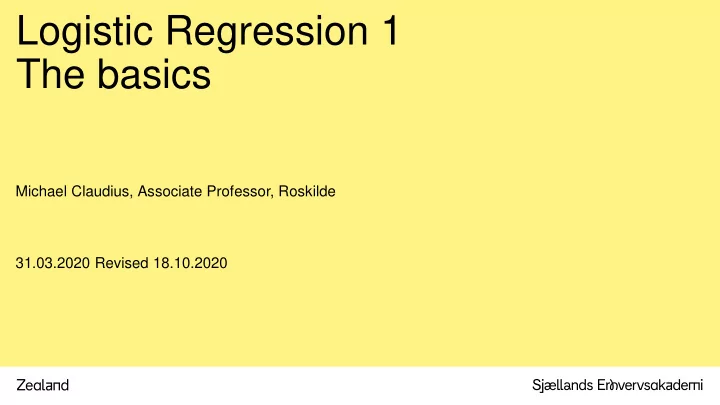

Logistic Regression 1 The basics Michael Claudius, Associate Professor, Roskilde 31.03.2020 Revised 18.10.2020 .
What is logistic regression? • A predicative algorithm for classification • Based on probability (p), a number • in percent: 0% ≤ p ≤ 100%; • in decimal: 0 ≤ p ≤ 1 • Binary classification OR • Multiple classes (multinomial) • Give you a minute! • Toss a coin. What is the probability of heads and tails (plat eller krone)? • Throw a dice. What is the probability for a 6? • Throw two dice a red and a green. • So its predicting something; lets look at that ! 2 2 0 . 1 0 .
Evaluation of logistic regression? • Advantages • Also good for small data sets! • White box; knows in details how it works • Easy • Disadvantages • Not good for big data, too slow • Wrong estimates for messy data, outliers • No missing data • Variables must be independent 3 2 0 . 1 0 .
Prediction • Prediction, y, of an instance X (X can be one feature (X 1 ) or many features (vector, X 1, X 2, … . X n ) ) • p ≥ 0.5 => y = 1 (X is an instance of a positive class) • p < 0.5 => y = 0 (X is an instance of a negative class) • Notice: logistic regression is not predicting a range of values just 0 or 1. (BAM) • Let us watch an easy video introduction Logistic Regression Introduction (8 minutes) • Before the hard stuff 4 2 0 . 1 0 .
Estimation elements • It is all math ; that ’ s it looks complicated so just keep it simple! • p: estimated probability • h: hypothesis function based on θ: h θ • X: feature vector or just feature values X 1 , X 2 , ….. X n • θ: parameter vector weights on features (θ 0 , θ 1 , θ 2 , ….. θ n ) • X T : transposed vector (columns changed to rows) • X T θ : matrix multiplication (like linear regression θ 0 + X 1 θ 1 + X 1 θ 1 ….. + X n θ n • σ: the famous sigmoid function ! • A link to Wikipedia 5 2 0 . 1 0 .
Sigmoid function • σ(t): values 0 – 1 ! 6 2 0 . 1 0 .
Training • Idea: to train the model (i.e. changing parameters θ 0 , θ 1 , θ 2 , ….. θ n ) • Goal: p is high for instance of positive class and low for instances of negative class • So need a cost function c( θ 0 , θ 1 , θ 2 , ….. θ n ) fulfilling: • Cost is high for wrong estimation (false) a. Guess 0 for a positive class b. Guess 1 for a negative class • Cost is low for correct estimation (true) a. Guess 1 for a positive class b. Guess 0 for a negative class • And yes it exists! We are lucky. 7 2 0 . 1 0 .
Cost function • This function for a single training instance fulfills the requirements • c: cost function • θ: parameter vector weights on features (θ 0 , θ 1 , θ 2 , ….. θ n ) • p: estimated probability • But of course there are many instances, so we need an average of summation … 8 2 0 . 1 0 .
Average cost function • But of course there are many instances, so we need an average of summation of the whole training set • J(θ): parameter vector weights on features (θ 0 , θ 1 , θ 2 , ….. θ n ) • How to find the best set ? • No Normal Equation ! • BUT Again we are lucky.. 9 2 0 . 1 0 .
Partial derivative of average cost function • Why Lucky?, because J( θ ) is convex and differentiable • • That ’ s it has a global minimum and then • We can find the parameters ( θ 0 , θ 1 , θ 2 , ….. θ n ) using Batch Gradient Algorithm ! (BAM) 10 2 0 . 1 0 .
Assignments • It is time for discussion and solving a few assignments in groups • Logistic Regression Questions 11 2 0 . 1 0 .
Recommend
More recommend